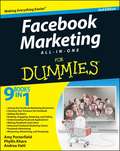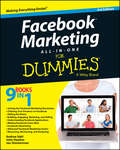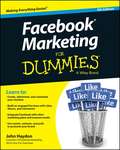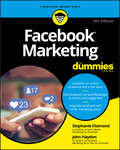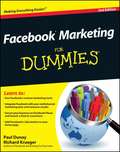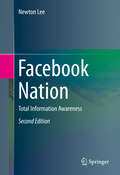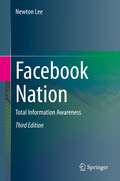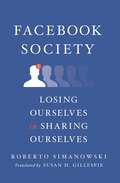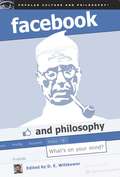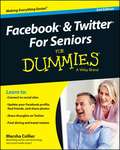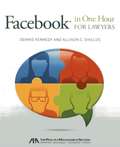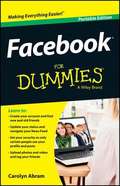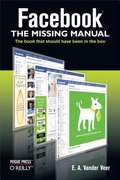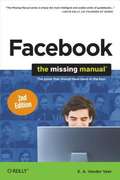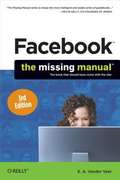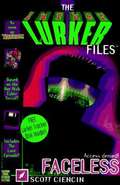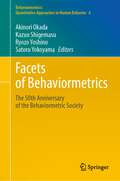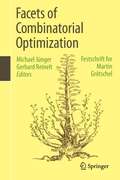- Table View
- List View
Facebook Marketing All-in-One For Dummies
by Phyllis Khare Amy Porterfield Andrea VahlGreat new edition covers what you need to know for successful Facebook marketingFacebook keeps evolving, and so does the social mediasphere. Even if you have a Facebook marketing strategy, have you taken into consideration Pinterest? Spotify? Foursquare? Facebook Marketing All-in-One For Dummies, 2nd Edition does. This detailed resource not only reveals how to create successful Facebook marketing strategies, it also shows you how to incorporate and use the entire social network to its full potential. Covers the tools, techniques, and apps you need to know to create successful Facebook marketing campaignsNine minibooks cover the essentials: Joining the Facebook Marketing Revolution; Claiming Your Presence On Facebook; Adding the Basics; Building, Engaging, Retaining, and Selling; Understanding Facebook Applications; Making Facebook Come Alive; Advanced Facebook Marketing Tactics; Facebook Advertising; Measuring, Monitoring, and AnalyzingExplores the new Timeline design for Pages, changes to Facebook Insights, new apps to incorporate into your strategy, and moreFacebook Marketing All-in-One For Dummies, 2nd Edition is the perfect resource for any marketer who wants to build or refine a social media marketing presence that includes Facebook.
Facebook Marketing All-in-One For Dummies
by Jan Zimmerman John Haydon Andrea VahlReach your customers with the latest Facebook marketing strategies Facebook Marketing All-in-One For Dummies, 3rd Edition is a detailed resource for businesses, brands, and people who are interested in promoting themselves, their goods, and their services on Facebook. Fully updated to cover new Facebook features, this new Third Edition includes guidance on Graph Search, the updated News Feed design, cover photo rules, advertising changes, updated mobile apps, and more. Examples and case studies illustrate best practices, and the book provides step-by-step guidance on creating a successful Facebook marketing campaign, from setting up a fan page to analyzing results. Facebook is considered the most fully-engaged social media platform for most marketers. With more than a billion users who comment over 3.2 billion times per day, Facebook provides a ready and willing customer base to businesses savvy enough to take advantage. Facebook Marketing All-in-One For Dummies, 3rd Edition walks you through the creation of a customized fan page, and guides you through interacting with fans and building a community around your brand. The book explains Facebook applications and Facebook advertising, and shows you how to make Facebook come alive. Learn how to claim your presence on Facebook Build pages to engage, retain, and sell to customers Discover advanced Facebook marketing tactics Find out why measuring, monitoring, and analyzing are important Create and curate engaging content, including photos, video, contests, and more, and watch your fan base grow. Social media marketing is a major force in the success of a business, and Facebook is at the forefront of it all. Facebook Marketing All-in-One For Dummies, 3rd Edition provides the guidance and information you need to get in there and claim your space.
Facebook Marketing For Dummies
by John HaydonThe bestselling book updated with all of the latest features and Facebook upgradesThis latest revision covers the newest Facebook tools and techniques, including how to use the Timeline for your business page and how to take advantage of third-party apps. It will also explore the psychology of the Facebook user, explain ways to build your fan base and increase brand awareness, look at how to promote your page with events and contests, and discuss ways to monitor and measure your efforts. Real-world case studies illustrate the techniques.Facebook is among the most important marketing tools for today's business or nonprofit organizationsThis extremely popular guidebook has been fully updated to cover Facebook's new and ever-evolving toolsShows how to create and administer the Timeline for your page, how to use events, contests, and polls to generate interest, ways to increase brand awareness, and how to integrate your Facebook marketing campaign with other marketing effortsIntroduces you to the psychology of a Facebook user, shows how third-party apps can be used with your Facebook presence, and helps you focus on tried-and-true strategies and techniquesFacebook Marketing For Dummies, 4th Edition is a must-read for businesses and nonprofits that want to succeed in today's social media environment.
Facebook Marketing For Dummies (For Dummies Series)
by Stephanie Diamond John HaydonAdd Facebook to your marketing plan—and watch your sales grow With 2 billion monthly active users across the world, Facebook has evolved into a community of consumers, creating a primary resource for marketers. This presents a demand for knowledge about how to strategically plan, execute, and analyze a successful Facebook marketing campaign. Now, the trusted Facebook Marketing For Dummies has been fully updated to cover the newest tools and features important to marketers and Facebook page owners. If you’re a marketer looking to effectively add Facebook to your overall marketing mix, consider this book the mecca of Facebook marketing. Inside, you'll discover the psychology of the Facebook user, establish a social media presence, increase your brand awareness, integrate Facebook marketing with other marketing strategies, learn to target a specific audience, and much more. Develop a desirable community Sell products and services Use Facebook events to drive sales Get new business tips and avoid common mistakes Whether you're a novice or a pro, you’re no stranger to the power of Facebook. And this book makes Facebook marketing that much more exciting and easy!
Facebook Marketing For Dummies, 2nd Edition
by Richard Krueger Paul DunayDiscover how to use Facebook to create successful marketing campaigns With more than 400 million active users and more than 25 billion pieces of content shared each month, Facebook is an exciting platform with infinite marketing possibilities. This how-to guide breaks it all down for you and shows you ways to reach your customers with effective marketing strategies, tactics, and techniques on Facebook. Packed with new and updated content, including coverage of the new universal "like" button and Open Graph, Facebook Marketing For Dummies, 2nd Edition is an essential starting point for developing a successful marketing campaign on Facebook. Boasts new and updated content for developing a successful Facebook marketing campaign Addresses ways to use tools such as events, contests, and polls to promote your page Introduces the new Open Graph to connect your Web site visitors through Facebook Explains how to integrate your Facebook marketing campaign with your other marketing campaigns using plug-ins and widgets Details ways to monitor, measure, and adjust your Facebook marketing campaigns Start campaigning the Facebook way with Facebook Marketing For Dummies, 2nd Edition!
Facebook Nation
by Newton LeePresident Barack Obama, in his 2011 State of the Union Address, called America "the nation of Edison and the Wright brothers" and "of Google and Facebook." U.S. Chief Information Officer, Steven VanRoekel, said that America has become a "Facebook nation" that demands increased transparency and interactivity from the federal government. Facebook as a nation in 2012 would be the third largest country in the world with over 900 million citizens, after China and India. This book portrays the social media ecosystem as a world of increasing Total Information Awareness, which is essentially a civilian version of the controversial Total Information Awareness program unveiled in 2002 by the Defense Advanced Research Projects Agency (DARPA) at the U.S. Department of Defense. Back in the 60's, DARPA initiated and funded the research and development of Advanced Research Projects Agency Network (ARPANET) that went online in 1969. The success of ARPANET gave rise to the global commercial Internet in the 90's and the new generation of Fortune 500 companies today including Amazon.com, Google, eBay, and Yahoo!. As if life comes full circle in the 21st century, private businesses and the ubiquity of social networks such as Facebook, Google+, Twitter, and YouTube are creating the technologies and infrastructures necessary for the DARPA-proposed Total Information Awareness program. WikiLeaks founder Julian Assange called Facebook "the most appalling spying machine that has ever been invented." Indeed, military and civilian technologies have interwoven into every fabric of our society, as Facebook co-founder and CEO Mark Zuckerberg said, "We exist at the intersection of technology and social issues." This book offers discourse and practical advice on the privacy issue in the age of big data, the rise of Facebook nation, and Total Information Awareness. Opening with President Ronald Reagan's 1984 National Security Decision Directive and ending with George Orwell's novel 1984, the author takes us on a roller-coaster ride through Facebook's botched IPO, Carrier IQ, Kony 2012, SOPA/PIPA blackout, cyber bullying, crime fighting, and a host of other timely issues facing our Facebook nation. Social media strategists, information architects, social scientists, policymakers, and academic scholars in the Program in Science, Technology, and Society (STS) will find this book a valuable asset.
Facebook Nation: Total Information Awareness
by Newton LeeThis book explores total information awareness empowered by social media. At the FBI Citizens Academy in February 2021, I asked the FBI about the January 6 Capitol riot organized on social media that led to the unprecedented ban of a sitting U.S. President by all major social networks. In March 2021, Facebook CEO Mark Zuckerberg, Google CEO Sundar Pichai, and Twitter CEO Jack Dorsey appeared before Congress to face criticism about their handling of misinformation and online extremism that culminated in the storming of Capitol Hill.With more than three billion monthly active users, Facebook family of apps is by far the world's largest social network. Facebook as a nation is bigger than the top three most populous countries in the world: China, India, and the United States. Social media has enabled its users to inform and misinform the public, to appease and disrupt Wall Street, to mitigate and exacerbate the COVID-19 pandemic, and to unite and divide a country.Mark Zuckerberg once said, "We exist at the intersection of technology and social issues." He should have heeded his own words. In October 2021, former Facebook manager-turned-whistleblower Frances Haugen testified at the U.S. Senate that Facebook's products "harm children, stoke division, and weaken our democracy."This book offers discourse and practical advice on information and misinformation, cybersecurity and privacy issues, cryptocurrency and business intelligence, social media marketing and caveats, e-government and e-activism, as well as the pros and cons of total information awareness including the Edward Snowden leaks."Highly recommended." - T. D. Richardson, Choice Magazine"A great book for social media experts." - Will M., AdWeek"Parents in particular would be well advised to make this book compulsory reading for their teenage children..." - David B. Henderson, ACM Computing Reviews
Facebook Society: Losing Ourselves in Sharing Ourselves
by Roberto SimanowskiFacebook claims that it is building a “global community.” Whether this sounds utopian, dystopian, or simply self-promotional, there is no denying that social-media platforms have altered social interaction, political life, and outlooks on the world, even for people who do not regularly use them. In this book, Roberto Simanowski takes Facebook as a starting point to investigate our social-media society—and its insidious consequences for our concept of the self.Simanowski contends that while they are often denounced as outlets for narcissism and self-branding, social networks and the practices they cultivate in fact remake the self in their image. Sharing is the outsourcing of one’s experiences, encouraging unreflective self-narration rather than conscious self-determination. Instead of experiencing the present, we are stuck ceaselessly documenting and archiving it. We let our lives become episodic autobiographies whose real author is the algorithm lurking behind the interface. As we go about accumulating more material for the platform to arrange for us, our sense of self becomes diminished—and Facebook shapes a subject who no longer minds. Social-media companies’ relentless pursuit of personal data for advertising purposes presents users with increasingly targeted, customized information, attenuating cultural memory and fracturing collective identity. Presenting a creative, philosophically informed perspective that speaks candidly to a shared reality, Facebook Society asks us to come to terms with the networked world for our own sake and for all those with whom we share it.
Facebook and Philosophy: What's on Your Mind?
by D. E. WittkowerFacebook and Philosophy is an entertaining, multi-faceted exploration of what Facebook means for us and for our relationships. With discussions ranging from the nature of friendship and its relationship to "friending," to the (debatable) efficacy of "online activism," this book is the most extensive and systematic attempt to understand Facebook.
Facebook and Twitter For Seniors For Dummies
by Marsha CollierA fun and easy social media guide for the over-55 setPeople over 55 were the fastest-growing user group on Facebook in the first half of 2009, and they're flocking to Twitter at a faster rate than their under-20 grandchildren. From basic information about establishing an Internet connection to rediscovering old friends, sharing messages and photos, and keeping in touch instantly with Twitter, this book by online expert Marsha Collier helps seniors jump right into social media.Seniors are recognizing the communication possibilities of Facebook and Twitter and are signing up in record numbersThis plain-English guide explains how to get online, set up a Facebook profile, locate friends, post public and private messages, share photos, create events, follow local businesses and friends on Twitter, create a blog, play games, and moreMarsha Collier explains every step with the same friendly, comfortable style that has made her eBay For Dummies books bestsellersFacebook & Twitter For Seniors For Dummies supplies everything seniors need to function confidently on these two social media platforms.
Facebook for Seniors: Connect with Friends and Family in 12 Easy Lessons
by Carrie Ewin Cheryl Ewin Chris EwinFacebook is the world’s largest internet community. It’s used by millions of people like you to connect with family and friends, share photos, and stay in touch. But if you’re new to Facebook, getting started can be a little tricky.Based on award-winning computer classes for seniors, the 12 lessons in Facebook for Seniors will show you how to do things like:–Sign up for Facebook and connect with family members and old friends–Instantly share photos and messages–Keep up-to-date with friends and loved ones–Chat about cars, gardening, travel, or anything else that interests you–Play games, and RSVP to parties and other events–Keep your account safe and secureStep-by-step instructions and full-color images make it easy to follow along. Activities throughout help you practice what you’ve learned, and if you get stuck, just flip to the solutions at the back of the book!Why let the kids have all the fun? Join the party.
Facebook in One Hour for Lawyers
by Dennis Kennedy Allison C. ShieldsMany lawyers use Facebook(r), the world's most popular social networking platform, to communicate with friends and family across the globe. But lawyers are missing a major opportunity if they do not consider the business possibilities of their Facebook(r) accounts. With a few simple steps, lawyers can harness Facebook(r) to market their services, grow their practices, and expand their legal network--all by using the same methods they already use to communicate with friends and family. Facebook(r) in One Hour for Lawyers will show any attorney--from Facebook(r) novices to advanced users--how to use this powerful tool for both professional and personal purposes. In just one hour, you will learn to: Set up a Facebook(r) account Optimize privacy and other settings Create a profile and manage your timeline Find, organize, and manage friends Use Facebook(r) search and navigation Participate on Facebook(r) with updates, comments, likes, and timelines Send messages, join groups, and subscribe to feeds Establish a business page Monitor your Facebook(r) network Develop a Facebook(r) strategy to grow your legal network"
Facebook, Portable Edition
by Carolyn AbramLearn to: Create your account and find new and old friends Update your status and navigate your News Feed Set your security so only certain people see your profile and posts Upload photos and video and tag your friends Ready to get active on Facebook but have no clue where to start? This guide gets you going! So you've finally decided to join the "social network. " Maybe you have a Facebook account but want help navigating the site. This handy guide tells you how to get started, set up your Timeline, find friends, protect your privacy, and much more. Discover how Facebook helps you make new connections and keep up with old friends. Get the basics right - learn how to add personal info, send Friend Requests, and set privacy controls Reach out - find friends, start chat sessions, share photos, and use tags Choose your audience - fine-tune the Friend Lists that Facebook makes for you Show off your smiling face - share your photos and videos with your Facebook friends Manage your profile - choose what you want to share and find out how to make changes to your information Keep in touch - contact your friends using private or public messages Open the book and find: Steps for finding and connecting with friends on Facebook Tips for changing your profile picture and cover photo How to tell your story in Timeline Privacy controls and how to set them Advice for parents of teens on Facebook Ways to interact with friends using comments, likes, and sharing
Facebook, Surfen und Co.: So ist mein Kind sicher im Internet
by Jane SchmidtKinder und Jugendliche bewegen sich heutzutage wie selbstverständlich im Internet - sei es mit dem Computer oder dem Smartphone. Dies ist auch durchaus unterstützenswert, da sie von zahlreichen Informations-, Kommunikations- und Unterhaltungsangeboten profitieren können. Die Vielzahl der Möglichkeiten bringt allerdings auch einige Gefahren mit sich - dieses Buch zeigt Ihnen, wie Sie Ihr Kind sicher davor schützen. Sie erfahren, wie Sie den Computer oder das Smartphone kindersicher einrichten, wie Ihr Kind spielerisch lernen kann, welche privaten Informationen es unbedingt schützen sollte, und wie es echte Freunde von zwielichtigen Fremden unterscheidet. Außerdem wird thematisiert, was Sie tun können, wenn Ihr Kind Opfer von Cybermobbing wird, versehentlich ein Abo abgeschlossen hat oder wenn aufgrund eines illegalen Musik- oder Film-Downloads eine Abmahnung ins Haus flattert. Und da sich gerade Jugendliche des Öfteren zurückziehen, erfahren Sie auch, woran Sie erkennen, ob Ihr Kind möglichweise schon onlinesüchtig ist. Im zweiten Teil des Buchs dreht sich dann alles konkret um die bei Kindern und Jugendlichen beliebtesten sozialen Netzwerke Facebook, Google+, YouTube, Twitter, Pinterest, Instagram und Foursquare. Sie lernen, worauf Ihr Kind grundsätzlich achten sollte, und legen Schritt für Schritt Profile an, die so abgesichert sind, dass die nächste "Facebook-Party" bestimmt nicht bei Ihnen stattfinden wird!
Facebook, Twitter, and Instagram For Seniors For Dummies
by Marsha CollierEnjoy the top social media sites with ease and security Done correctly, social media is a way to connect friends, family, and the world while still maintaining security and privacy. Facebook, Twitter, & Instagram For Seniors For Dummies, 3rd Edition offers advice on how to enjoy the three most popular social media options while avoiding worry about who sees what you share. Written by social media expert Marsha Collier, this book walks you through establishing accounts, making connections, and sharing content including photos and video. You learn the settings to adjust on each platform to maintain privacy and filter out the content you don't want. This book also explains the subtle art of avoiding or blocking people on social platforms without jeopardizing your real-world relationships! Take control of what you share Connect with others Take and share your best pictures Use social media as a news source Social media sites are great fun once you learn how to cut through the clutter—and this book shows you how!
Facebook: The Missing Manual
by E. A. Vander VeerFacebook is the wildly popular, free social networking site that combines the best of blogs, online forums and groups, photosharing, clever applications, and interaction among friends. The one thing it doesn't have is a users guide to help you truly take advantage of it. Until now. Facebook: The Missing Manual gives you a very objective and entertaining look at everything this fascinating Facebook phenomenon has to offer. Teeming with high-quality color graphics, each page in this guide is uniquely designed to help you with specific Facebook tasks, such as signing up, networking, shopping, joining groups, finding or filling a job, and a whole lot more. You'll discover how to create your page and make connections with other members in no time -- everybody who went to your school, for example, or those who work at your company or play on your soccer team. Bingo: instant access to the personal and professional details of all the folks you're connected with, the folks they're connected with, and so on, and so on. With Facebook: The Missing Manual, you learn to: Join a network, whether it's in your area, or work-related, or based on other interests Look up old friends, find new ones, and decide who you'd like to keep track of Contact members by poking them, writing on their walls, and sending them gifts Get automatic updates from Facebook friends and send updates to them Participate in groups of particular interest and hook up with members face-to-face Buy and sell using Facebook's uniquely targeted marketplace and classified ads Find a job or hire employees by combing through Facebook's member pool Use Facebook as a collaboration tool to keep team members, co-workers, clients, and projects up to date Play it safe by using a multi-pronged approach to ensuring your privacy Think of Facebook as a 30-million-plus-entry searchable Rolodex on steroids! With help from this Missing Manual, you'll quickly get in the swim of the Facebook experience -- without getting in over your head.
Facebook: The Missing Manual
by E. A. Vander VeerFacebook's popularity is skyrocketing, drawing more than 400 million people to this combination online village green, personal website creator, and souped-up address book. But one thing you won't get when signing up is a printed manual. Enter Facebook: The Missing Manual, Second Edition -- the witty, authoritative guide you need, now revised and updated to include all of Facebook's latest features. Coverage includes: Getting started, getting connected. Signing up is easy, but the real payoff comes when you tap into networks of coworkers, classmates, and friends. This book explains it all-including how to pick and choose who gets to see what, and how to steer clear of people you want to avoid. Adding applications. Ranging from silly (fortune cookies and video games) to serious (goal tracking), thousands of mini-programs can transform your Facebook account into an addictive, one-stop resource. Learn how to find and install your favorites. Facebook for grownups and businesspeople. Facebook isn't just for Junior anymore. Thousands of companies and business professionals use the site for everything from project collaboration and advertising to filling (and finding) jobs. This book is written for adults of all ages. Protecting your privacy. Creeps are everywhere online, but on Facebook you can feel especially exposed with so much personal info on display. This book offers an easy-to-follow, multi-pronged approach to staying safe.
Facebook: The Missing Manual
by E. A. Vander VeerFacebook's spreading about as far and fast as the Web itself: 500 million members and counting. But there's a world of fun packed into the site that most folks miss. With this bestselling guide, learn how to unlock Facebook's talents as personal website creator, souped-up address book, and bustling community forum. It's an eye-opening, timesaving tour, guaranteed to help you get the most out of your Facebook experience. Coverage includes: Get started, get connected. Signing up is easy, but the real payoff comes when you tap into networks of coworkers, classmates, and friends. Pick and choose who gets to see what, and learn how to steer clear of people you want to avoid. Add applications. Transform your Facebook account into an addictive, one-stop resource with thousands of mini-programs, ranging from silly to serious. Go professional. Facebook isn't just for college kids. Thousands of companies and businesspeople use the site for everything from project collaboration and advertising to filling (and finding) jobs. You'll learn all the tricks. Protect your privacy. You may feel too exposed with so much personal info on display. This book features an easy-to-follow, multi-pronged approach to staying safe on Facebook.
Facebook®: How Mark Zuckerberg Connected More Than a Billion Friends
by Celicia ScottToday, Facebook is one of the most-used websites on the Internet, visited by millions of users each day and home to more than 500 million accounts. Many people use Facebook to share pictures, news, and ideas with friends--but they may not know the true story behind Facebook's massive success. Facebook began as the idea of one college student: Mark Zuckerberg. Discover how Mark founded one of the most successful social networking sites on the Internet while he was still in school. Learn how he first got Facebook growing, and how he keeps millions of people logging in day after day. Find out more about the man behind Facebook--and learn what's next for his company.
Facebook—Can Ethics Scale in the Digital Age?
by Carin-Isabel Knoop George A. RiedelSince its founding in 2004, Facebook has built a phenomenally successful business at global scale to become the fifth most valuable public company in the world. The revelation of Cambridge Analytica events in March 2018, where 78 million users' information was leaked in a 2016 US election cycle, exposed a breach of trust/privacy amongst its user community. In the past, growth at any costs appeared to be the de facto strategy. Now many voices such as regulators, advertisers, ethicists, shareholders and users argued for a more responsible approach to addressing their concerns. Mark Zuckerberg (CEO/Chair/Founder) and Sheryl Sandberg (COO) mapped out their six-point plan to address this existential threat. Could they continue to grow and rectify the breach of trust/privacy? Did other stakeholders have some greater responsibility too? In addition to issues of privacy and trust, there is a growing chorus of concern about "content moderation" - not for the easy topics like spam or copyright material -but for the hard things around political points of view, hate speech, polarizing perspectives, etc. How will Facebook strike the balance between free speech and corrosive content across billions of users and dozens of languages? Are they the arbiters of truth/censorship in the digital world?
Faceless (The Lurker Files #1)
by Scott CiencinPlaying the popular campus video game, The Lurker, Josh Stewart is horrified to learn that his roommate and opponent, Wreak Havoc, is out to secure Josh's permanent elimination.
Faces of Geometry. From Agnesi to Mirzakhani (Lecture Notes in Networks and Systems #88)
by Paola Magnaghi-Delfino Giampiero Mele Tullia NorandoThe volume reports on interdisciplinary discussions and interactions between theoretical research and practical studies on geometric structures and their applications in architecture, the arts, design, education, engineering, and mathematics. These related fields of research can enrich each other and renew their mutual interest in these topics through networks of shared inspiration, and can ultimately enhance the quality of geometry and graphics education. Particular attention is dedicated to the contributions that women have made to the scientific community and especially mathematics. The book introduces engineers, architects and designers interested in computer applications, graphics and geometry to the latest advances in the field, with a particular focus on science, the arts and mathematics education.
Faces of Geometry: II Edition (Lecture Notes in Networks and Systems #172)
by Paola Magnaghi-Delfino Giampiero Mele Tullia NorandoThe volume reports on interdisciplinary discussions and interactions between theoretical research and practical studies on geometric structures and their applications in architecture, the arts, design, education, engineering, and mathematics. These related fields of research can enrich each other and renew their mutual interest in these topics through networks of shared inspiration, and can ultimately enhance the quality of geometry and graphics education. Particular attention is dedicated to the contributions that women have made to the scientific community and especially mathematics. The book introduces engineers, architects and designers interested in computer applications, graphics and geometry to the latest advances in the field, with a particular focus on science, the arts and mathematics education.
Facets of Behaviormetrics: The 50th Anniversary of the Behaviormetric Society (Behaviormetrics: Quantitative Approaches to Human Behavior #4)
by Akinori Okada Kazuo Shigemasu Satoru Yokoyama Ryozo YoshinoThis edited book is the first one written in English that deals comprehensively with behavior metrics. The term “behaviormetrics” comprehends the research including all sorts of quantitative approaches to disclose human behavior. Researchers in behavior metrics have developed, extended, and improved methods such as multivariate statistical analysis, survey methods, cluster analysis, machine learning, multidimensional scaling, corresponding analysis or quantification theory, network analysis, clustering, factor analysis, test theory, and related factors. In the spirit of behavior metrics, researchers applied these methods to data obtained by surveys, experiments, or websites from a diverse range of fields. The purpose of this book is twofold. One is to represent studies that display how the basic elements of behavior metrics have developed into present-day behavior metrics. The other is to represent studies performed mainly by those who would like to pioneer new fields of behavior metrics and studies that display elements of future behavior metrics. These studies consist of various characteristics such as those dealing with theoretical or conceptual subjects, the algorithm, the model, the method, and the application to a wide variety of fields. This book helps readers to understand the present and future of behavior metrics.
Facets of Combinatorial Optimization: Festschrift for Martin Grötschel
by Michael Jünger Gerhard ReineltMartin Grötschel is one of the most influential mathematicians of our time. He has received numerous honors and holds a number of key positions in the international mathematical community. He celebrated his 65th birthday on September 10, 2013. Martin Grötschel's doctoral descendant tree 1983-2012, i.e., the first 30 years, features 39 children, 74 grandchildren, 24 great-grandchildren, and 2 great-great-grandchildren, a total of 139 doctoral descendants. This book starts with a personal tribute to Martin Grötschel by the editors (Part I), a contribution by his very special "predecessor" Manfred Padberg on "Facets and Rank of Integer Polyhedra" (Part II), and the doctoral descendant tree 1983-2012 (Part III). The core of this book (Part IV) contains 16 contributions, each of which is coauthored by at least one doctoral descendant. The sequence of the articles starts with contributions to the theory of mathematical optimization, including polyhedral combinatorics, extended formulations, mixed-integer convex optimization, superclasses of perfect graphs, efficient algorithms for subtree-telecenters, junctions in acyclic graphs, and preemptive restricted strip covering, as well as efficient approximation of non-preemptive restricted strip covering. Combinations of new theoretical insights with algorithms and experiments deal with network design problems, combinatorial optimization problems with submodular objective functions, and more general mixed-integer nonlinear optimization problems. Applications include VLSI layout design, systems biology, wireless network design, mean-risk optimization, and gas network optimization. Computational studies include a semidefinite branch and cut approach for the max k-cut problem, mixed-integer nonlinear optimal control, and mixed-integer linear optimization for scheduling and routing of fly-in safari planes. The two closing articles are devoted to computational advances in general mixed integer linear optimization, the first by scientists working in industry, the second by scientists working in academia. These articles reflect the "scientific facets" of Martin Grötschel who has set standards in theory, computation, and applications.
